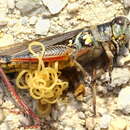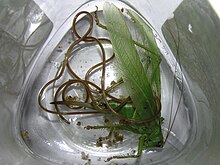pt-BR
nomes no trilho de navegação


Little is known about communication in this species. It is likely to be based on touch and chemo-sensing. These worms can sense chemicals, touch, and moisture, and adult females have an unusual (for nematodes) light-sensing structure.
Communication Channels: tactile ; chemical
Other Communication Modes: pheromones
Perception Channels: visual ; tactile ; chemical
The status of populations of this species are unknown, but it is not believed to require special conservation. The species has not been rated by the IUCN, or other agencies.
US Federal List: no special status
CITES: no special status
State of Michigan List: no special status
Embryos begin to develop in the eggs while still in the female. By the time the eggs are laid (in late spring or early summer) the offspring are already stage 2 larvae. If an egg is ingested by a grasshopper or other orthopteran, the outer layer of the egg rubs off and within minutes the larva begins to move out of the inner shell.
Once hatched, the larva pierces the gut wall of the host and enters the body cavity. Larval worms feed on host body fluids and tissues and grow. They emerge from the host in approximately 3-6 weeks. The worms develop faster in warmer temperatures. Size and species of hosts affects developmental time, and larval worms stay longer and grow larger in mature adult hosts than in nymph or young adult hosts. Female worms tend to remain in the host longer than males, and are larger at emergence than males. Worms puncture the host body wall and emerge as 4th stage larvae (the host and any remaining worms die). They crawl 15-20 cm into the soil where they molt, become mature adults and mate. Males die after mating. Females spend the winter in diapause in the soil and emerge on rainy or dew mornings in the following spring/summer to climb up on to plants and lay their eggs.
Development - Life Cycle: diapause
Normally these worms have no known adverse effects on humans. There are a very small number of cases of M. nigrescens finding its way into humans, but this is extremely rare. Poinar and Hoberg (1988) describe a case where a female was found in an infant's mouth, and give references to the few similar cases.
These worms could potentially be used as control agents for pest grasshoppers. However, nematode ecology is poorly understood, especially in nature.
Larva of this nematode are parasites of orthopteran insects, and can sometimes have substantial effects on host populations.
Ecosystem Impact: parasite
Species Used as Host:
Larva feed on amino acids, lipids, and carbohydrates from the hemolymph of the host. The free-living adults do not eat.
Animal Foods: body fluids
Primary Diet: carnivore (Eats body fluids)
Mermis nigrescens is reported from many locations in North America and Europe. Related species are known from Africa.
Biogeographic Regions: nearctic (Native ); palearctic (Native )
Adults of Mermis nigrescens live buried in the soil, while larva live as parasites inside grasshoppers. The species is more frequently found in grasslands, meadows, clearings, and other well-vegetated but not tree-covered habitats.
Habitat Regions: temperate ; terrestrial
Terrestrial Biomes: savanna or grassland ; chaparral ; forest
Other Habitat Features: suburban ; agricultural
Most Mermis nigrescens complete their lifecycle in one year, but in the absence of rains or other moisture to trigger egg-laying, females can persist in the soil for 2-3 years. Females die shortly after climbing out of the soil to lay eggs.
Range lifespan
Status: wild: 3 (high) years.
Typical lifespan
Status: wild: 1 (high) hours.
This is a large species of nematode. Adult males range from 40 to 50 mm long, while the females range from 80 to 200 mm long. The body of the worm tapers in the front, with the head slightly offset and rounded in the front. Larvae and adult males are generally cream colored, as are females if their uterus is empty. If the uterus contains eggs, the female will appear brownish or black because of the coloration of the eggs she contains. Males have two spicules, one of which is used in reproduction. Both sexes possess two laterally-placed anterior chemoreceptors called amphids, but they lack posterior phasmids. Both sexes also possess a terminal mouth with two lateral papillae close to it and four head papillae further back.
In adult females, there is an orange/red area behind the head, which is associated with a unique light sensitive organ. Mohammed et al (2007) give details of the structure and function of this organ. It serves to allow the female to know where to go when laying eggs.
Range length: 40 to 200 mm.
Other Physical Features: ectothermic ; heterothermic ; bilateral symmetry ; polymorphic
Sexual Dimorphism: female larger; sexes colored or patterned differently; sexes shaped differently
The predators of this species are unknown, but likely include predators of soil invertebrates, such as carabid beetles, centipedes, and shrews.
Males mate with many females, while the female will only mate with one male. Males have a flexible tail including one of the spicules which they use to wrap around the female and hold the female in place during copulation.
Mating System: polygynous
After spending the winter in the soil, emerge in the late spring or early summer on damp or rainy mornings, and climb on the leaves of plants, usually 30-60 cm above soil level and lay thousands of dark brown eggs on the leaves. The eggs are attached with threads of adhesive.
Eggs from unmated females have been found to be viable, so apparently parthenogenesis is possible in this species.
Breeding interval: Breed once yearly
Breeding season: ummer
Range number of offspring: 2000 (low) .
Average age at sexual or reproductive maturity (female): 1 years.
Average age at sexual or reproductive maturity (male): 1 years.
Key Reproductive Features: semelparous ; seasonal breeding ; gonochoric/gonochoristic/dioecious (sexes separate); parthenogenic ; sexual ; fertilization (Internal ); oviparous
No parental care is provided after eggs are laid. Females provision the eggs with a coating that protects them from sunlight damage, and glue to hold them onto leaves.
Parental Investment: pre-fertilization (Protecting: Female)
Mermis nigrescens is a species of nematode known commonly as the grasshopper nematode.[1][2] It is distributed in the Americas, Europe, and Asia. It occurs in Tasmania, but it has not been observed on mainland Australia. It has been rarely observed in Africa.[1] It is a parasite of insects, especially grasshoppers.[1]
This is a very large nematode, the male about 4 to 6 centimetres long[1] and the female known to exceed 20 centimetres.[3] The size is unusual for entomopathogenic nematodes, which are generally almost microscopic.[2] The body is pale brown,[2] and the gravid female has a dark stripe down the length of its body due to the presence of up to 14,000 eggs.[1] The body surface is smooth. It tapers at the front end, and the head and tail are rounded.[3]
The adult female has a bright red[4] or orange-red[3] spot on its head. Early in studies of the nematode, this was called the "chromatrope", because it apparently had a function in the animal's response to light.[4] On closer examination it had the form of a hollow cylinder,[5] and the red pigment inside was determined to be hemoglobin.[4] This haemoglobin, generally as oxyhaemoglobin, is densely concentrated in crystalline form.[5] The cylinder was confirmed to be an ocellus, a form of eye.[6] Haemoglobin takes the place of melanin as the shadowing pigment of the eye, and plays a role in the nematode's sensation of light, a function not observed in any other organism.[5] Some other nematodes have eye structures, but that of the female M. nigrescens is unique. It has a single eye, where other nematodes have two. Only the female has an eye, where eyes are present in both sexes of other eyed nematodes. Its eye takes up the entire front end of the body, the cylinder filling the entire body cavity. It has a cornea, or a structure that acts as a cornea. All other eyed nematodes have melanin as the shadowing pigment. The unique eye of M. nigrescens probably evolved independently among nematode taxa.[7]
This and other Mermis species are sometimes mistaken for horsehair worms, but the latter are longer and uniformly dark in colour, and their bodies do not taper.[1]

The adult male and female nematode mate in spring or summer. The male then dies and the female remains in the soil through fall and winter. During the following spring or summer the female emerges after a rainfall event while the landscape is still wet, often early in the morning. It then climbs vegetation, sometimes reaching 2 or 3 meters above the ground. It lays its eggs on plants. The eggs are dark brown or reddish, and are about half a millimetre long. The eggs attach to the plant via filaments called byssi. They are consumed by herbivores along with the plant tissue.[1]
This nematode is most often associated with grasshoppers. High levels of parasitism have been reported in species such as the two-striped grasshopper (Melanoplus bivittatus), the red-legged grasshopper (Melanoplus femurrubrum), the migratory grasshopper (Melanoplus sanguinipes), the snakeweed grasshopper (Hesperotettix viridis),[1] and the desert locust (Schistocerca gregaria).[8] Once it is ingested by an insect such as a grasshopper, an egg hatches almost immediately, sometimes within an hour. The juvenile nematode pierces the gut with its stylet and enters the hemocoel, the blood-like fluid that fills the insect's body cavity, acting as a circulatory system. There the nematode absorbs the insect's nutrients, taking glucose directly through its cuticle.[8] It grows and develops over several weeks. The newly hatched nematode is about 0.24 millimetres long; by day 37 it has reached about 5 centimetres. The nematodes grow more rapidly and attain larger sizes in larger insect hosts. More females occur in larger hosts, as well. The nematode is still a juvenile when it emerges from the host insect, and finishes its development in the soil. The insect dies as the nematode exits its body, if not before.[1] The adult nematode does not feed.[9]
M. nigrescens exhibits positive phototaxis; when it senses light with its eye, it moves toward it. Other eyed nematodes have a negative phototaxis, moving away from light. The juvenile M. nigrescens also has a weak negative phototaxis before its eye has developed. This behaviour may guide the juvenile underground, and lead the adult female to the surface, where it lays its eggs on vegetation.[7]
The nematode moves in a unique fashion, as well. The anterior tip of the body containing the eye swings horizontally and vertically while the "neck" region just behind it bends slowly.[6] This is apparently a scanning behaviour, in which the nematode senses light and determines its direction.[7] Rather than undulating as nematodes generally do, this species moves its body as several independent sections, pushing off of objects with some sections while others loop upward.[9] It also crawls on its ventral surface "like a snake",[1] rather than on its side like a typical nematode.[9]
In naturally infected earwig hosts (Forficula auricularia) in New Zealand a prevalence of 7.8% was observed. With around 10% of individuals carrying multiple worms. The highest observed number of M. nigrescens in one host was 5. [10]
When infecting earwigs the parasite is able to induce positive hydrotaxis. Larger M. nigrescens are more likely to induce positive hydrotaxis which is probably related to maturation of the worms. [10]
Mermis nigrescens is a species of nematode known commonly as the grasshopper nematode. It is distributed in the Americas, Europe, and Asia. It occurs in Tasmania, but it has not been observed on mainland Australia. It has been rarely observed in Africa. It is a parasite of insects, especially grasshoppers.